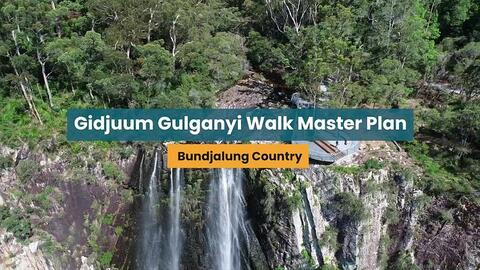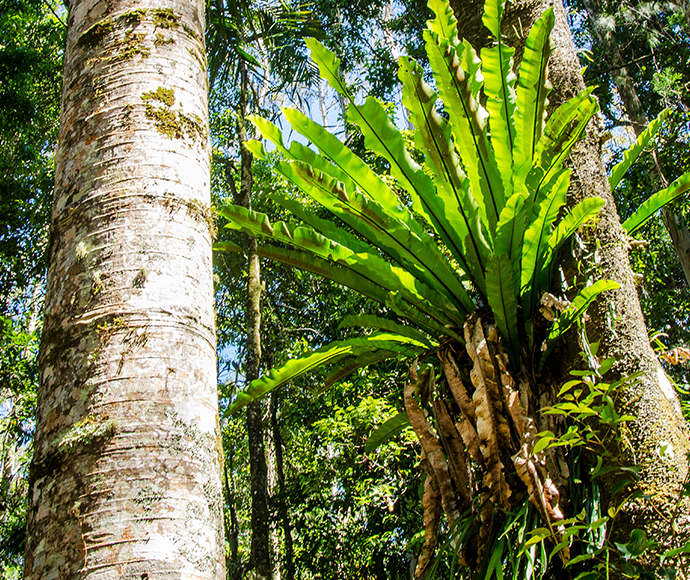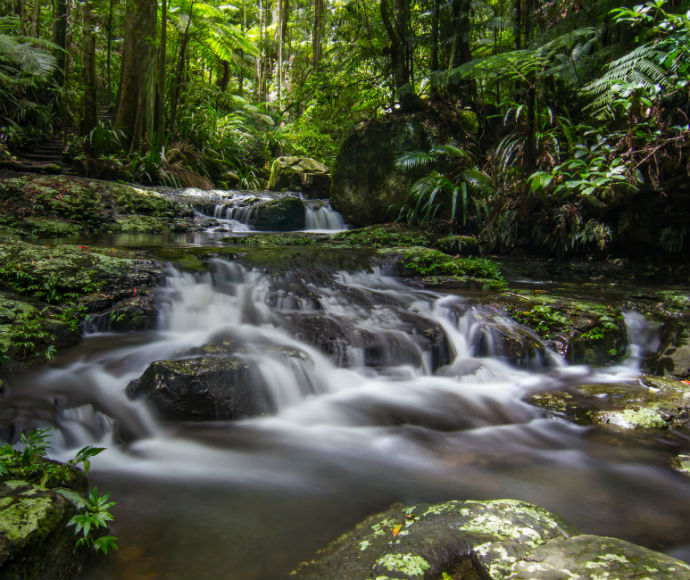The draft Tweed Byron Hinterland Trail master plan has been revised and is now known as the Gidjuum Gulganyi Walk Master Plan.
The master plan provides a framework for the delivery of the 39-kilometre multi-day Gidjuum Gulganyi Walk from Mount Jerusalem National Park near Uki to Minyon Falls in Nightcap National Park, traversing the traditional lands of the Widjabul Wia-bal and Minjungbal people of the Bundjalung Nation.
The walk's name, 'Gidjuum Gulganyi', means 'Old People's Track' and was jointly chosen by the Widjabul Wia-bal Native Title Holders and the Wollumbin Consultative Group.
Final master plan
Following the public exhibition of the Tweed Byron Hinterland Walk draft master plan in late 2022 and further technical assessments, we considered all submissions and feedback received. We made the following changes to the draft master plan:
- walk to start from the new Unicorn Falls car park at Manns Road
- re-alignment of Day 2 and Day 3 sections of the walk
- total walk distance increased to 39 km, reflecting track start and alignment changes
- included options for additional side tracks and loop walks
- minor design changes to Camp 2.
- renamed Camp 3 as 'Weeun Weeun' camp.
The revised concept will deliver an exceptional visitor experience as part of the Tweed Byron Hinterland Trail project while minimising the impact on the park's natural and cultural values and surrounding local communities.
Project benefits
The walk will broaden access to this beautiful part of the world, strengthen the appeal of New South Wales as a walking destination and provide opportunities for a more diverse range of visitors to enjoy our spectacular national parks.
This project will boost the local economy by extending visitor stays and expanding visitor opportunities in the Northern Rivers region outside Byron Bay.
The National Parks and Wildlife Service is consulting and developing partnerships with local Aboriginal communities to present the area's rich cultural heritage to visitors by offering guided experiences led by Aboriginal people.
Feedback from public consultation
The draft master plan was available online and in hard copy at 4 locations on the North Coast – Murwillumbah, Byron Bay, Kyogle and Alstonville. We notified over 430 stakeholders directly about the consultation period.
During the public exhibition period, we received 62 submissions via emails, online forms and surveys.
Submissions were from a variety of stakeholders, including residents, business operators, local government, park visitors and bushwalking groups. Points raised in submissions fell into 11 themes. See the Submissions summary for details.
How will park values be protected?
The new walk has been carefully designed to ensure the natural and cultural values of the parks, including threatened species, ecological communities and Aboriginal cultural and historic heritage, are protected and conserved.
A review of environmental factors has been prepared to consider the environmental impact of the new walk on lands managed by National Parks and Wildlife Service.
The review of environmental factors includes detailed assessments of the proposed route's natural and Aboriginal cultural heritage values. It examines the significance of likely environmental impacts of the proposal and the measures required to mitigate any adverse impacts.
Several modifications have been made to the review of environmental factors to accommodate the changes proposed through public feedback. The review of environmental factors and the modifications can be read in conjunction with the master plan to provide a detailed picture of the scope of works.
Extensive consultation and fieldwork with a range of interested groups, including the Widjabul Wia-bal Native Title Holders, the Wollumbin Aboriginal Consultative Group and Tweed Byron Local Aboriginal Land Council, have resulted in adjustments to the walking track route alignment to avoid areas of exceptional environmental and cultural significance.
The project will ensure a sustainable visitor experience while also maintaining, protecting and conserving park values in accordance with the National Parks and Wildlife Act.
What happens next?
Construction is scheduled to commence in 2023.
Project updates will be published on the Tweed Byron Hinterland Trails project webpage.
Download
- Gidjuum Gulganyi Walk Master Plan
- Submissions summary: Public exhibition of Tweed Byron Hinterland Walk draft master plan
- Tweed Byron Hinterland Trail Walk Review of Environmental Factors
- Nightcap National Park: Addendum Report: Modification of a Determined Review of Environmental Factors
- Tweed Byron Hinterland Walk Natural Heritage Values Assessment
- Parks and Reserves of the Tweed Caldera Plan of Management


